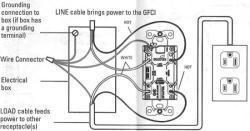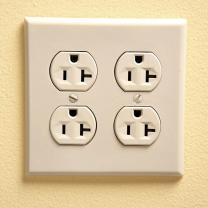How many wires in a 220 volt circuit?
A 220-volt circuit typically consists of three wires. These wires are:
Two Hot Wires: These wires are often colored black and red (though colors can vary), and they carry the voltage from the electrical source to the device or appliance being powered. Each hot wire carries 110 to 120 volts of electricity, and when combined, they provide a total of 220 to 240 volts.
One Ground Wire: The ground wire is typically green or bare copper. Its primary purpose is to provide a safe path for electrical current to travel in case of a fault, such as a short circuit. The ground wire helps prevent electrical shocks and protects against electrical fires.
In some cases, a 220-volt circuit may also include a neutral wire, especially in split-phase electrical systems commonly found in residential settings. In this configuration, the neutral wire is typically white. The neutral wire carries any unbalanced current and helps stabilize the voltage in the circuit. However, not all 220-volt circuits have a neutral wire; it depends on the specific electrical system and the type of appliance or device being powered.
It's essential to follow electrical codes and safety guidelines when working with 220-volt circuits, as improper wiring can lead to electrical hazards and damage to equipment. If you are not experienced with electrical work, it is advisable to consult a licensed electrician for installation, maintenance, or repairs involving 220-volt circuits.
Understanding the Wiring of a 220-Volt Circuit
A 220-volt circuit is a type of electrical circuit that supplies a voltage of 220 volts. This type of circuit is commonly used to power large appliances and equipment, such as electric ovens, dryers, and air conditioners.
220-volt circuits typically have three wires: two hot wires and a ground wire. The hot wires are energized with opposite polarities, which creates the 220-volt potential difference. The ground wire provides a safe path for stray current to flow to ground, thereby preventing electrical shock.
The wiring of a 220-volt circuit is typically as follows:
- The hot wires are connected to the circuit breaker in the main electrical panel.
- The hot wires are then run to the appliance or equipment that is being powered by the circuit.
- The ground wire is connected to the ground bus bar in the main electrical panel.
- The ground wire is also connected to the metal frame of the appliance or equipment.
Components and Configuration of a 220-Volt Electrical Circuit
The following are the main components of a 220-volt electrical circuit:
- Circuit breaker: The circuit breaker protects the circuit from overloads and short circuits.
- Hot wires: The hot wires carry the electrical current to the appliance or equipment.
- Ground wire: The ground wire provides a safe path for stray current to flow to ground.
- Appliance or equipment: The appliance or equipment is the device that is powered by the circuit.
Safety Precautions for Working with 220-Volt Wiring
220-volt circuits can be dangerous if not handled properly. Here are some safety precautions to follow when working with 220-volt wiring:
- Always turn off the power to the circuit before working on it. This can be done by flipping the circuit breaker to the "OFF" position.
- Use insulated tools to work on electrical circuits. This will help to protect you from electric shock.
- Be aware of your surroundings and avoid working on electrical circuits near water or other conductive materials.
- If you are not comfortable working with electricity, it is best to call an electrician.
Here are some additional safety tips to keep in mind:
- Make sure that the circuit breaker is properly sized for the load that it will be powering.
- Use the correct type of wiring for the circuit.
- Install the wiring in a safe and secure manner.
- Have the circuit inspected by a qualified electrician before using it.
By following these safety precautions, you can help to prevent accidents and injuries when working with 220-volt wiring.












